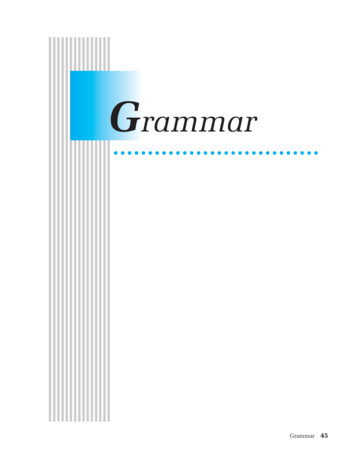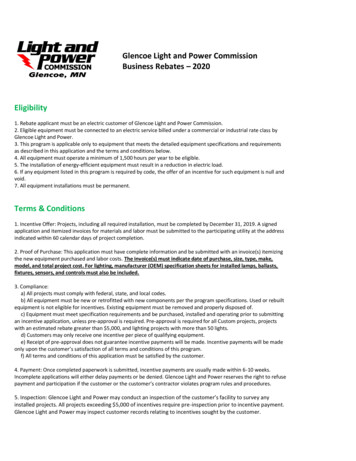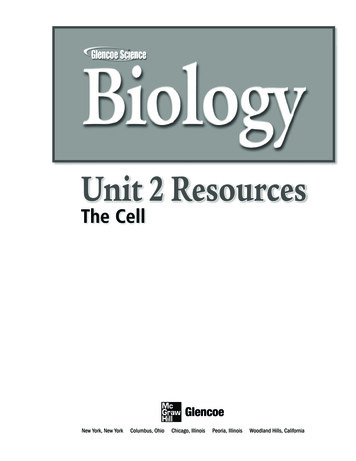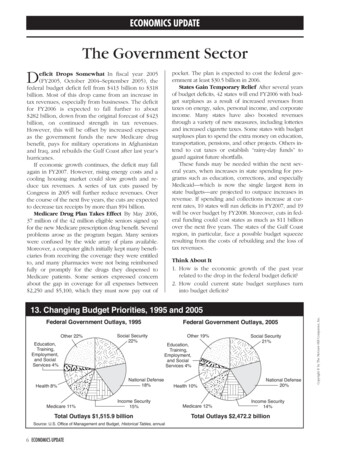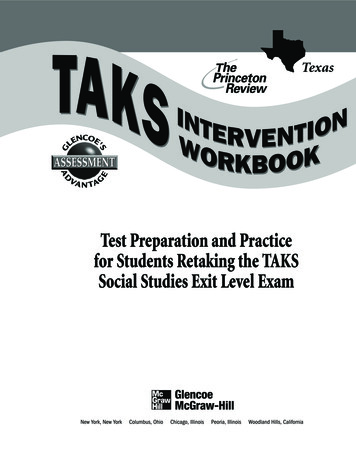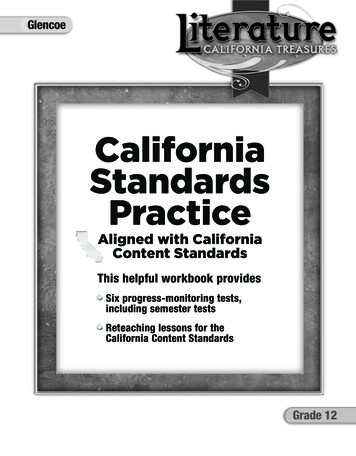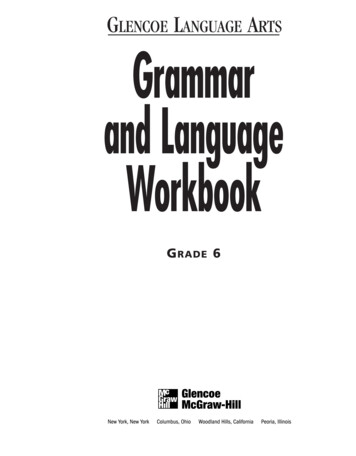
Transcription
GLENCOE LANGUAGE ARTSGrammarand LanguageWorkbookG RADE 6
Glencoe/McGraw-HillCopyright by The McGraw-Hill Companies, Inc. All rights reserved. Except as permitted under the United StatesCopyright Act of 1976, no part of this publication may be reproduced or distributed in any form or means, or stored ina database or retrieval system, without the prior written permission of the publisher.Send all inquiries to:Glencoe/McGraw-Hill8787 Orion PlaceColumbus, Ohio 43240-4027ISBN 0-07-820539-5Printed in the United States of America2 3 4 5 6 7 8 9 1000903 02 01 00
ContentsHandbook of Definitions and Rules .1Troubleshooter .23Part 1 Grammar .45Unit 1 Subjects, Predicates, and Sentences1.1Kinds of Sentences: Declarativeand Interrogative .471.2Kinds of Sentences: Exclamatoryand Imperative .491.3Subjects and Predicates: Simpleand Complete .511.4Subjects and Predicates: Compound .531.5Simple and Compound Sentences .551.6Sentence Fragments .571.7Run-On Sentences.59Unit 1 Review .61Cumulative Review .62Copyright by Glencoe/McGraw-HillUnit 2 Nouns2.8Nouns: Proper and Common .632.9Nouns: Singular and Plural .652.10Nouns: Collective .672.11Nouns: Possessives .69Unit 2 Review .71Cumulative Review: Units 1–2.72Unit 3 Verbs3.12Action Verbs and Direct Objects .753.13Action Verbs and Indirect Objects .773.14Transitive and Intransitive Verbs .793.15Linking Verbs and Predicate Words .813.16Verb Tenses: Present, Past, and Future .833.17Main Verbs: Principal Parts .853.18Helping Verbs.873.19Verb Forms: Present Progressiveand Past Progressive.893.20Perfect Tenses: Present and Past .913.21Irregular Verbs I.933.22Irregular Verbs II .953.23Irregular Verbs III .973.24More Practice with Verb Forms.99Unit 3 Review .101Cumulative Review: Units 1–3 .102Unit 4 Pronouns4.25Personal Pronouns .1054.26Using Pronouns Correctly.1074.27Pronouns and Antecedents.1094.28Possessive Pronouns .1114.29Indefinite Pronouns .113Unit 4 Review .115Cumulative Review: Units 1-4 .116Unit 5 Adjectives5.30Adjectives and Proper Adjectives .1195.31Articles and Demonstratives.1215.32Adjectives That Compare.1235.33Special Adjectives That Compare .125Unit 5 Review .127Cumulative Review: Units 1–5.128Unit 6 Adverbs6.34Adverbs Modifying Verbs .1316.35Adverbs Modifying Adjectivesand Adverbs .1336.36Adverbs That Compare .1356.37Irregular Comparative Forms.1376.38Telling Adjectives andAdverbs Apart I .1396.39Telling Adjectives andAdverbs Apart II.1416.40Avoiding Double Negatives .143Unit 6 Review .145Cumulative Review: Units 1–6 .146Unit 7 Prepositions, Conjunctions, and Interjections7.41Prepositions.1497.42Prepositional Phrases.1517.43Pronouns After Prepositions.1537.44Prepositional Phrases as Adjectivesand Adverbs .1557.45Telling Prepositions andAdverbs Apart .1577.46Conjunctions .1597.47Interjections.161Unit 7 Review .163Cumulative Review: Units 1–7.164Unit 8 Subject-Verb Agreement8.48Making Subjects and Verbs Agree .1678.49Subject Pronouns andVerb Agreement.1698.50Locating the Subject.1718.51Agreement with CompoundSubjects.173Unit 8 Review .175Cumulative Review: Units 1– 8 .176Unit 9 Diagraming Sentences9.52Diagraming Simple Subjectsand Simple Predicates .1799.53Diagraming the Four Kindsof Sentences.1819.54Diagraming Direct and IndirectObjects and Predicate Words.1839.55Diagraming Adjectives and Adverbs .1859.56Diagraming Prepositional Phrases.1879.57Diagraming CompoundSentence Parts .189Unit 9 Review .191Cumulative Review: Units 1– 9 .192Table of Contentsiii
Part 3 Mechanics .211Unit 11 Capitalization11.63 Capitalizing Sentences, Quotations,and Salutations I .21311.64 Capitalizing Sentences, Quotations,and Salutations II .21511.65 Capitalizing Names andTitles of Persons I.21711.66 Capitalizing Names andTitles of Persons II.21911.67 Capitalizing Names of Places I .22111.68 Capitalizing Names of Places II .22311.69 Capitalizing Other Proper Nounsand Adjectives I.22511.70 Capitalizing Other Proper Nounsand Adjectives II .227Unit 11 Review .229Cumulative Review: Units 1–11 .230Unit 12 Punctuation12.71 Using the Period andOther End Marks .23312.72 Using Commas I .23512.73 Using Commas II .23712.74 Using Commas III .23912.75 Using Commas IV.24112.76 Commas in Review.24312.77 Semicolons and Colons.24512.78 Quotation Marks.24712.79 Quotation Marks and Italics .24912.80 Apostrophes .25112.81 Hyphens.25312.82 Abbreviations I .25512.83 Abbreviations II.25712.84 Writing Numbers I.25912.85 Writing Numbers II .261Unit 12 Review .263Cumulative Review: Units 1–12 .264Part 4 Vocabulary and Spelling .267Unit 13 Vocabulary and Spelling13.86 Building Vocabulary: Learningfrom Context.26913.87 Building Vocabulary: Prefixes .27113.88 Building Vocabulary: Suffixes.27313.89 Synonyms and Antonyms.27513.90 Homonyms .27713.91 Basic Spelling Rules I .279iv Grammar and Language Workbook, Grade 613.92 Basic Spelling Rules II .28113.93 Basic Spelling Rules III .28313.94 Often Misspelled Words .28513.95 Easily Confused Words .28713.96 Review: Building Vocabulary .28913.97 Review: Basic Spelling Rules .291Unit 13 Review .293Cumulative Review: Units 1–13 .294Part 5 Composition.297Unit 14 Composition14.98 The Writing Process: Prewriting I .29914.99 The Writing Process: Prewriting II .30114.100 The Writing Process: Drafting I .30314.101 The Writing Process: Drafting II .30514.102 The Writing Process: Revising I.30714.103 The Writing Process: Revising II .30914.104 The Writing Process: Editing .31114.105 The Writing Process: Presenting.31314.106 Outlining .31514.107 Writing Effective Sentences I.31714.108 Writing Effective Sentences II .31914.109 Writing Effective Sentences III .32114.110 Building Paragraphs I.32314.111 Building Paragraphs II .32514.112 Building Paragraphs III .32714.113 Paragraph Ordering .32914.114 Personal Letters I.33114.115 Personal Letters II.33314.116 Personal Letters III .33514.117 Business Letters: Letters of Requestor Complaint.33714.118 Business Letters: Lettersof Opinion .339Index.341TAE TestsUnit 1: Subjects, Predicates, andSentences.349Unit 2: Nouns .351Unit 3: Verbs.353Unit 4: Pronouns .357Unit 5: Adjectives .359Unit 6: Adverbs .361Unit 7: Prepositions, Conjunctions, andInterjections.365Unit 8: Subject-Verb Agreement .369Unit 9: Diagraming Sentences.371Unit 10: Usage Glossary .373Unit 11: Capitalization .375Unit 12: Punctuation .377Unit 13: Vocabulary and Spelling .381Unit 14: Composition .383Answer Key to Testing Program .387Copyright by Glencoe/McGraw-HillPart 2 Usage .195Unit 10 Usage Glossary10.58 Usage: accept to a lot .19710.59 Usage: beside to chose .19910.60 Usage: in to learn.20110.61 Usage: leave to sit.20310.62 Usage: than to whose .205Unit 10 Review .207Cumulative Review: Units 1–10 .208
Handbook ofDefinitionsand RulesHandbook1
HandbookSUBJECTS AND PREDICATES1. The simple subject is the key noun or pronoun that tells what the sentence is about. Acompound subject is made up of two or more simple subjects that are joined by aconjunction and have the same verb.The lantern glows.Moths and bugs fly nearby.2. The simple predicate is the verb or verb phrase that expresses the essential thoughtabout the subject of the sentence. A compound predicate is made up of two or moreverbs or verb phrases that are joined by a conjunction and have the same subject.Rachel jogged down the hill.Pete stretched and exercised for an hour.3. The complete subject consists of the simple subject and all the words that modify it.Golden curly hair framed the child’s face.The soft glow of sunset made her happy.4. The complete predicate consists of the simple predicate and all the words that modifyit or complete its meaning.Lindy ate a delicious muffin for breakfast.The apple muffin also contained raisins.5. Usually the subject comes before the predicate in a sentence. In inverted sentences, allor part of the predicate precedes the subject.(You) Wait for me at the corner. (request)Through the toys raced the children. (inverted)Is the teacher feeling better? (question)There are seats in the first row.Copyright by Glencoe/McGraw-HillPARTS OF SPEECHNouns1. A singular noun is a word that names one person, place, thing, or idea.auntmeadowpencilfriendshipA plural noun names more than one person, place, thing, or idea.auntsmeadowspencilsfriendships2. To help you determine whether a word in a sentence is a noun, try adding it to thefollowing sentences. Nouns will fit in at least one of these sentences:He said something about .I know something about a(n) .He said something about aunts.I know something about a meadow.3. A common noun names a general class of people, places, things, or ideas.sailorcityholidaymusicA proper noun specifies a particular person, place, thing, event, or idea. Proper nounsare always capitalized.Captain AhabRomeMemorial DayTreasure IslandHandbook3
An abstract noun names an idea, a quality, or a characteristic.loyaltyhonestydemocracyfriendship5. A collective noun names a group. When the collective noun refers to the group as awhole, it is singular. When it refers to the individual group members, the collectivenoun is plural.The family eats dinner together every night. (singular)The council vote as they wish on the pay increase. (plural)6. A possessive noun shows possession, ownership, or the relationship between two nouns.Monica’s bookthe rabbit’s earsthe hamster’s cageVerbs1. A verb is a word that expresses action or a state of being and is necessary to make astatement. A verb will fit one or more of these sentences:He .We .She it.He knows.We walk.She sees it.2. An action verb tells what someone or something does. The two types of action verbs aretransitive and intransitive. A transitive verb is followed by a word or words—called thedirect object—that answer the question what? or whom? An intransitive verb is notfollowed by a word that answers what? or whom?Transitive: The tourists saw the ruins.The janitor washed the window.Intransitive: Owls hooted during the night.The children played noisily.3. An indirect object receives what the direct object names.Marcy sent her brother a present.4. A linking verb links, or joins, the subject of a sentence with an adjective or a noun.The trucks were red. (adjective)She became an excellent swimmer. (noun)5. A verb phrase consists of a main verb and all its auxiliary, or helping, verbs.We had been told of his arrival.They are listening to a symphony.6. Verbs have four principal parts or forms: base, past, present participle, and pastparticiple. Form the past and past participle by adding -ed to the base.Base: I talk.Present Participle: I am talking.Past: I talked.Past Participle:I have talked.4 Grammar and Language Workbook, Grade 6Copyright by Glencoe/McGraw-HillHandbook4. A concrete noun names an object that occupies space or that can be recognized by anyof the senses.leafmelodydeskaroma
Handbook7. Irregular verbs form the past and past participle in other ways.Copyright by Glencoe/McGraw-HillPRINCIPAL PARTS OF IRREGULAR VERBSBase egogrowhanghanghaveknowlayPast Formwas, vewentgrewhunghangedhadknewlaidPast Participlebeenbeatenbecomebegunbitten or kdriveneatenfallenfeltfoundflownfrozengot or gottengivengonegrownhunghangedhadknownlaidBase hrowwearwinwritePast hrank orshrunksangsatspokesprang otePast aidseensetshrunk ldthoughtthrownwornwonwritten8. The principal parts are used to form six verb tenses. The tense of a verb expresses time.Simple TensesPresent Tense: She speaks. (present or habitual action)Past Tense:She spoke. (action completed in the past)Future Tense: She will speak. (action to be done in the future)Perfect TensesPresent Perfect Tense: She has spoken. (action just done or still in effect)Past Perfect Tense:She had spoken. (action completed before some other pastaction)Future Perfect Tense: She will have spoken. (action to be completed before somefuture time)Handbook5
10. The voice of a verb shows whether the subject performs the action or receives the actionof the verb. A sentence is in the active voice when the subject performs the action. Asentence is in the passive voice when the subject receives the action of the verb.The robin ate the worm. (active)The worm was eaten by the robin. (passive)Pronouns1. A pronoun takes the place of a noun, a group of words acting as a noun, or anotherpronoun.2. A personal pronoun refers to a specific person or thing. First-person personalpronouns refer to the speaker, second-person pronouns refer to the one spoken to, andthird-person pronouns refer to the one spoken about.SingularPluralFirst PersonI, me, my, minewe, us, our, oursSecond Personyou, your, yoursyour, your, yoursThird Personhe, she, it, him, her, his, hers, itsthey, them, their, theirs3. A reflexive pronoun refers to the subject of the sentence. An intensive pronoun addsemphasis to a noun or another pronoun. A demonstrative pronoun points out specificpersons, places, things, or ideas.Reflexive:Nikki prepares himself for the day-long hike.Intensive:Nikki himself prepares for the day-long hike.Demonstrative: That was a good movie! These are the files you wanted.4. An interrogative pronoun is used to form questions. A relative pronoun is used tointroduce a subordinate clause. An indefinite pronoun refers to persons, places, orthings in a more general way than a personal pronoun does.Interrogative: Whose are these? Which did you prefer?Relative:The bread that we tasted was whole wheat.Indefinite:Someone has already told them. Everyone agrees on the answer.5. Use the subject form of a personal pronoun used as a subject or when it follows a linkingverb.He writes stories.Are they ready?It is I. (after linking verb)6. Use the object form of a personal pronoun when it is an object.Mrs. Cleary called us. (direct object)Stephen offered us a ride. (indirect object)Sara will go with us. (object of preposition)7. Use a possessive pronoun to replace a possessive noun. Never use an apostrophe in apossessive personal pronoun.Their science experiment is just like ours.6 Grammar and Language Workbook, Grade 6Copyright by Glencoe/McGraw-HillHandbook9. Progressive forms of verbs are made up of a form of be and a present participle andexpress a continuing action. Emphatic forms are made up of a form of do and a baseform and add emphasis or ask questions.Progressive: Marla is babysitting.The toddlers have been napping for an hour.Emphatic:They do prefer beef to pork.We did ask for a quiet table.
Handbook8. When a pronoun is followed by an appositive, use the subject pronoun if theappositive is the subject. Use the object pronoun if the appositive is an object. To testwhether the pronoun is correct, read the sentence without the appositive.We eighth-graders would like to thank you.The success of us geometry students is due to Ms. Marcia.9. In incomplete comparisons, choose the pronoun that you would use if the missingwords were fully expressed.Harris can play scales faster than I (can).It is worth more to you than (it is to) me.10. In questions use who for subjects and whom for objects.Who wants another story?Whom will the class choose as treasurer?In subordinate clauses use who and whoever as subjects after linking verbs, and usewhom and whomever as objects.These souvenirs are for whoever wants to pay the price.The manager will train whomever the president hires.11. An antecedent is the word or group of words to which a pronoun refers or that apronoun replaces. All pronouns must agree with their antecedents in number, gender,and person.Marco’s sister spent her vacation in San Diego.The huge old trees held their own against the storm.Copyright by Glencoe/McGraw-Hill12. Make sure that the antecedent of a pronoun is clearly stated.UNLCLEAR: Mrs. Cardonal baked cookies with her daughters, hoping to sell themat the bake sale.CLEAR: Mrs. Cardonal baked cookies with her daughters, hoping to sell thecookies at the bake sale.UNLCLEAR: If you don’t tie the balloon to the stroller, it will blow away.CLEAR: If you don’t tie the balloon to the stroller, the balloon will blow away.Adjectives1. An adjective modifies, or describes, a noun or pronoun by providing more informationor giving a specific detail.The smooth surface of the lake gleamed.Frosty trees glistened in the sun.2. Most adjectives will fit this sentence:The one seems very .The handmade one seems very colorful.3. Articles are the adjectives a, an, and the. Articles do not meet the preceding test foradjectives.4. A proper adjective is formed from a proper noun and begins with a capital letter.Tricia admired the Scottish sweaters.Our Mexican vacation was memorable.Handbook7
6. Some adjectives have irregular comparative forms.POSITIVE:good, E:bestworstfarthestmany, muchmoremostlittlelessleastAdverbs1. An adverb modifies a verb, an adjective, or another adverb. Adverbs tell how, where,when, or to what extent.The cat walked quietly. (how)She seldom misses a deadline. (when)The player moved forward. (where)The band was almost late. (to what extent)2. Many adverbs fit these sentences:She thinks .She thinks fast.She thinks quickly.She thinks unusually fast.She thinks fast.She seldom thinks fast.3. The comparative form of an adverb compares two actions. The superlative formcompares more than two actions. For shorter adverbs add -er or -est to form thecomparative or superlative. For most adverbs, add more or most or less or least to formthe comparative or superlative.We walked faster than before.They listened most carefully to the final speaker.4. Avoid double negatives, which are two negative words in the same clause.INCORRECT: I have not seen no stray cats.CORRECT:I have not seen any stray cats.Prepositions, Conjunctions, and Interjections1. A preposition shows the relationship of a noun or a pronoun to some other word. Acompound preposition is made up of more than one word.The trees near our house provide plenty of shade.The schools were closed because of snow.2. Common prepositions include these: about, above, according to, across, after, against,along, among, around, as, at, because of, before, behind, below, beneath, beside,besides, between, beyond, but, by, concerning, down, during, except, for, from, in,inside, in spite of, into, like, near, of, off, on, out, outside, over, past, round, since,through, till, to, toward, under, underneath, until, up, upon, with, within, without.8 Grammar and Language Workbook, Grade 6Copyright by Glencoe/McGraw-HillHandbook5. The comparative form of an adjective compares two things or people. The superlativeform compares more than two things or people. Form the comparative by adding -er orcombining with more or less. Form the superlative by adding -est or combining withmost or estcharmingmore charmingmost charming
Handbook3. A conjunction is a word that joins single words or groups of words. A coordinatingconjunction joins words or groups of words that have equal grammatical weight.Correlative conjunctions work in pairs to join words and groups of words of equalweight. A subordinating conjunction joins two clauses in such a way as to make onegrammatically dependent on the other.I want to visit the art gallery and the museum. (coordinating)Both left and right turns were impossible in the traffic. (correlative)We go to the park whenever Mom lets us. (subordinating)COMMON deither.orSubordinating:afteralthoughasas ifas long asas soon asfornororneither.nornot only.but alsoas thoughbecausebeforeeven thoughifin order thatsoyetwhether.orsinceso whetherwhile4. A conjunctive adverb clarifies a relationship.Frank loved the old maple tree; nevertheless, he disliked raking its leaves.5. An interjection is an unrelated word or phrase that expresses emotion or strong feeling.Look, there are two cardinals at the feeder.Good grief! Are you kidding?Copyright by Glencoe/McGraw-HillCLAUSES AND COMPLEX SENTENCES1. A clause is a group of words that has a subject and a predicate and is used as a sentenceor a part of a sentence. There are two types of clauses: main and subordinate. A mainclause has a subject and a predicate and can stand alone as a sentence. A subordinateclause has a subject and a predicate, but it cannot stand alone as a sentence.mainsub.She became a vegetarian because she loves animals.2. There are three types of subordinate clauses: adjective, adverb, and noun.a. An adjective clause is a subordinate clause that modifies a noun or pronoun.The wrens that built a nest in the backyard are now raising their young.b. An adverb clause is a subordinate clause that often modifies the verb in the mainclause of the sentence. It tells when, where, how, why, or under what conditions.Before they got out, the goats broke the fence in several places.c. A noun clause is a subordinate clause used as a noun.Whatever we do will have to please everyone. (subject)The prize goes to whoever can keep the squirrels away from the feeder. (object ofpreposition)Handbook9
mainmainCompound: The dancers bowed, and the audience clapped.Complex:sub.mainBecause they turn to face the sun, these flowers are called sunflowers.4. A sentence that makes a statement is classified as a declarative sentence.My dad’s favorite horses are buckskins.An imperative sentence gives a command or makes a request.Please close the door on your way out.An interrogative sentence asks a question.When will the mail carrier arrive?An exclamatory sentence expresses strong emotion.Watch out!What a view that is!Phrases1. A phrase is a group of words that acts in a sentence as a single part of speech.2. A prepositional phrase is a group of words that begins with a preposition and endswith a noun or pronoun, which is called the object of the preposition. A prepositionalphrase can act as an adjective or an adverb.The house on the hill is white. (modifies the noun house)Everyone in the house heard the storm. (modifies the pronoun everyone)The geese flew toward warmer weather. (modifies the verb flew)3. An appositive is a noun or pronoun that is placed next to another noun or pronoun toidentify it or give more information about it. An appositive phrase is an appositive plusits modifiers.Our sister Myra is home from college. Her college, Purdue University, is in Indiana.4. A verbal is a verb form that functions in a sentence as a noun, an adjective, or anadverb. A verbal phrase is a verbal and other words that complete its meaning.a. A participle is a verbal that functions as an adjective. Present participles end in -ing.Past participles usually end in -ed.The squeaking floor board gave me away.The twisted tree was ancient.b. A participial phrase contains a participle and other words that complete itsmeaning.Moving quickly across the room, the baby crawled toward her mother.10 Grammar and Language Workbook, Grade 6Copyright by Glencoe/McGraw-HillHandbook3. Main and subordinate clauses can form several types of sentences. A simple sentencehas only one main clause and no subordinate clauses. A compound sentence has two ormore main clauses. A complex sentence has at least one main clause and one or moresubordinate clauses.mainSimple:The apples fell off the tree.
Handbookc. A gerund is a verbal that ends in -ing. It is used in the same way a noun is used.Sailing is a traditional vacation activity for the Andersons.d. A gerund phrase is a gerund plus any complements or modifiers.Walking to school is common for many school children.e. An infinitive is a verbal formed from the word to and the base form of a verb. It isoften used as a noun. Because an infinitive acts as a noun, it may be the subject of asentence or the direct object of an action verb.To sing can be uplifting. (infinitive as subject)Bab
Unit 6 Adverbs 6.34 Adverbs Modifying Verbs.131 6.35 Adverbs Modifying Adjectives and Adverbs .133 6.36 Adverbs That Compare.135 6.37 Irregular Comparative F

